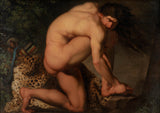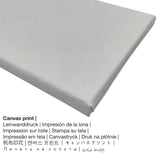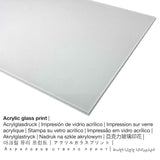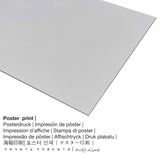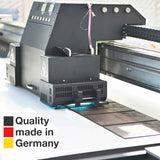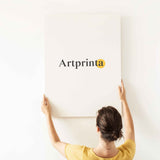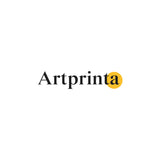Nicolai Abildgaard, 1775 - De sårede filokteter - kunsttryk
Inkl. Moms Forsendelse beregnes ved kassen.
Om dette mere end 240 år gamle maleri
Det over 240 år gammelt kunstværk blev skabt af Danske maler Nicholas Abildgaard in 1775. The piece of art belongs to the Statens Museum for Kunst (Statens Museum for Kunst). kunstsamling, som er det største museum for billedkunst i Danmark og er tilknyttet det danske kulturministerium.. Med høflighed af Danmarks Nationalgalleri (offentligt domæne).: . Hvad mere er, er tilpasningen landskab and has a ratio of 1.4 : 1, which implies that the length is 40% longer than the width. Nicolai Abildgaard was a painter from Denmark, whose style can mainly be assigned to Romanticism. The Romanticist painter lived for a total of 66 år, født i 1743 in Copenhagen and died in the year 1809 in Copenhagen.
Produktmaterialer, som vores kunder kan vælge
In the dropdown selection right next to the article you can pick your prefered size and material. The following options are available for individualization:
- Akrylglasprint (med ægte glasbelægning): The print on acrylic glass, which is sometimes described as a UV print on plexiglass, makes the original work of art into wonderful wall décor and offers a distinct alternative to dibond and canvas prints. Your favorite artwork is manufactured with modern UV direct printing machines. The special effect of this are sharp and rich colors.
- Aluminium dibond print: An Aluminium Dibond print is a material with a true depth effect. The non-reflective surface structure creates a fashionable impression. A direct Aluminium Dibond Print is your ideal introduction to art replicas with aluminum. For our Direct Aluminium Dibond option, we print the favorite artpiece right onto the surface of the white-primed aluminum composite. This direct print on aluminium is one of the most popular entry-level products and is a truly sophisticated way to showcase art, since it puts the viewer’s focus on the image.
- Plakattrykket (lærredsmateriale): The poster print is a UV printed canvas paper with a nice surface finish. Please note, that depending on the absolute size of the poster print we add a white margin of something between 2-6cm around the print motif, which facilitates the framing.
- Lærred print: The canvas print is a printed cotton canvas mounted on a wooden frame. Canvas prints are relatively low in weight. That means, it is quite simple to hang your Canvas print without any wall-mounts. Canvas prints are suitable for any type of wall in your house.
Juridisk ansvarsfraskrivelse: We try our utmost to depict our products as closely as possible and to exhibit them visually on the respective product detail pages. Still, some colors of the print products and the print result might diverge somehwat from the presentation on your screen. Depending on your settings of your screen and the quality of the surface, not all colors are printed as exactly as the digital version. Because all fine art prints are printed and processed manually, there may as well be slight variations in the motif's size and exact position.
Produktet
| Produkttype: | kunstgengivelse |
| Reproduktionsmetode: | gengivelse i digitalt format |
| Fremstillingsteknik: | UV direkte print (digital print) |
| Produkt Oprindelse: | produceret i Tyskland |
| Lager type: | On Demand |
| Tilsigtet produktanvendelse: | boligdesign, vægkunst |
| Justering af kunstværket: | landskabelig tilpasning |
| Billedformat: | 1.4 : 1 - (længde : bredde) |
| Implikation af billedformat: | længden er 40 % længere end bredden |
| Tilgængelige produktmaterialer: | lærredstryk, plakattryk (lærredspapir), metaltryk (aluminium dibond), akrylglastryk (med ægte glasbelægning) |
| Lærred på båreramme (lærredstryk) varianter: | 70x50 cm - 28x20", 140x100 cm - 55x39" |
| Akrylglasprint (med ægte glasbelægning) varianter: | 70x50 cm - 28x20", 140x100 cm - 55x39" |
| Plakattryk (lærredspapir): | 70x50 cm - 28x20" |
| Aluminium print (aluminium dibond materiale) størrelse varianter: | 70x50 cm - 28x20", 140x100 cm - 55x39" |
| Indramning af kunsteksemplaret: | Uden ramme |
information om kunstværker
| Maleriets titel: | "The Wounded Philoctetes" |
| Kategorisering: | maleri |
| Kunstkategorisering: | klassisk kunst |
| Århundrede: | 18th århundrede |
| Oprettet i året: | 1775 |
| Kunstværkets alder: | omkring 240 år gammel |
| Museum: | Statens Museum for Kunst (Statens Museum for Kunst) |
| Museets placering: | København, Danmark |
| Web-URL: | Statens Museum for Kunst (Statens Museum for Kunst) |
| Licens til kunstværket: | offentlige domæne |
| Venligst udlånt af: | Danmarks Nationalgalleri |
Kort oversigt over kunstneren
| Navn: | Nicholas Abildgaard |
| Kunstnerens køn: | mand |
| Kunstner nationalitet: | Danske |
| Jobs: | maler |
| Oprindelsesland: | Danmark |
| Klassificering af kunstneren: | gammel mester |
| Kunststile: | Romantikken |
| Døde i alderen: | 66 år |
| Fødselsår: | 1743 |
| Fødselssted: | København |
| Dødsår: | 1809 |
| Døde i (sted): | København |
Denne tekst er beskyttet af copyright © | www.artprinta.com (Artprinta)
General information from Statens Museum for Kunst (National Gallery of Denmark) (© Copyright - Statens Museum for Kunst (National Gallery of Denmark) - Statens Museum for Kunst (Statens Museum for Kunst))
From 1772 Abildgaard spent five years in Rome thanks to a scholarship granted by the Royal Danish Academy of Fine Arts in Copenhagen. It was while in Rome that he created this depiction of the legendary hero Philoctetes, whose screams of pain caused by a festering snakebite made his comrades-in-arms abandon him on a Greek island during the Trojan war.
Challenging neoclassicism The dominant and deeply rooted movement within figure painting at this time was neoclassicism with its emphasis on self-command and calm. Abildgaard challenges this pattern with his depiction of a body convulsively curved around an axis of pain; a body that feels like it is forcefully restrained within the picture field with its tense musculature and twisted limbs.
Avantgarde, pathos and Weltschmerz The 1770s brought with them an increased emphasis on grand passions among the Northern European ”avant-garde”, and this new outlook also left its mark on Abildgaard’s circles in Rome. The interest in pathos and Weltschmerz is clearly evident in his works from this era.
In this case he used a principal work of classical sculpture as the basis for his rendition of Philoctetes’ tormented state: The Torso Belvedere in the Vatican museum served as the model for the plastic and mannered rendition of the hero’s upper body. With this move, Abildgaard’s stylistic innovation was imbued with features of a work canonised by neoclassicism – without, however, reducing the tensions in the painting.

